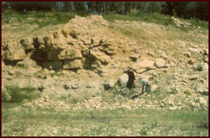Introduction
Fossils have been arranged by Phylum and Stratigraphy. Images and descriptions are found for each fossil type. The number in the paranthesis indicates the number of items in a collection.

Lithology (kind of rock) and Morphology (body structure) of Fossils
Geologists who have worked in the late Pennsylvanian and early Permian strata that are exposed throughout the mid-continent have observed that rock sequences are often repetitious. They have attached the name cyclothem to these kinds of deposits. R. C. Moore in Kansas, T. Mylan Stout in Nebraska and Philip Heckel in Iowa have all worked with these rocks. Cyclothems are usually named for the thick, regressive limestone contained within them. The names for these units that Heckel proposed are used below. The limestone beds alternate with shale beds and these are called from bottom to top:
Nearshore shale
These may include continental deposits near the base and marine deposits near the top. This shows an encroaching sea. The invertebrate fossils found in this unit are large and have thick, ornamented shells.
Transgressive limestone
This unit is a thin, dense limestone that was deposited nearer the shore toward its base and farther offshore near its top. The fossils found near the top of the transgressive limestone are usually small and have thin shells, suggesting they lived in deep, cold water. The richest fossil populations are often found at the contact between the transgressive limestone below and the offshore shale above.
Offshore shale
The offshore shale is usually a dark gray near its base and it grades upward into a black, fissile shale. It was deposited in deep, poorly oxygenated water and there was insufficient sunlight to algae to produce carbonates for limestone. The fossils in the dark gray shale are small and have thin, unornamented shells. The black shale usually contains few fossils that mostly of organisms that sunk to the substrate when they died. These fossils include abundant microscopic conodonts and some spectacular fish remains.
Regressive Limestone
The regressive limestone is very similar in lithology and fossil to the transgressive limestone near its base as the water column was still deep and cold as the sea withdrew. The limestone becomes less dense and more coarsely crystalline nearer the top and the fossils are larger, have thicker shells and more ornamentation that suggests they lived in warmer, shallower water.